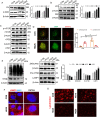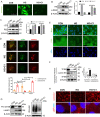TFEB-Mediated Lysosomal Restoration Alleviates High Glucose-Induced Cataracts Via Attenuating Oxidative Stress
- PMID: 35758908
- PMCID: PMC9248753
- DOI: 10.1167/iovs.63.6.26
TFEB-Mediated Lysosomal Restoration Alleviates High Glucose-Induced Cataracts Via Attenuating Oxidative Stress
Abstract
Purpose: Diabetic cataract (DC) is a visual disorder arising from diabetes mellitus (DM). Autophagy, a prosurvival intracellular process through lysosomal fusion and degradation, has been implicated in multiple diabetic complications. Herein, we performed in vivo and in vitro assays to explore the specific roles of the autophagy-lysosome pathway in DC.
Methods: Streptozotocin-induced DM and incubation in high glucose (HG) led to rat lens opacification. Protein Simple Wes, Western blot, and immunoassay were utilized to investigate autophagic changes in lens epithelial cells (LECs) and lens fiber cells (LFCs). RNA-sequencing (RNA-seq) was performed to explore genetic changes in the lenses of diabetic rats. Moreover, autophagy-lysosomal functions were examined using lysotracker, Western blot, and immunofluorescence analyses in HG-cultured primary rabbit LECs.
Results: First, DM and HG culture led to fibrotic LECs, swelling LFCs, and eventually cataracts. Further analysis showed aberrant autophagic degradation in LECs and LFCs during cataract formation. RNA-seq data revealed that the differentially expressed genes (DEGs) were enriched in the lysosome pathway. In primary LECs, HG treatment resulted in decreased transcription factor EB (TFEB) and cathepsin B (CTSB) activity, and increased lysosomal size and pH values. Moreover, TFEB-mediated dysfunctional lysosomes resulted from excessive oxidative stress in LECs under HG conditions. Furthermore, TFEB activation by curcumin analog C1 alleviated HG-induced cataracts through enhancing lysosome biogenesis and activating protective autophagy, thereby attenuating HG-mediated oxidative damage.
Conclusions: In summary, we first identified that ROS-TFEB-dependent lysosomal dysfunction contributed to autophagy blockage in HG-induced cataracts. Additionally, TFEB-mediated lysosomal restoration might be a promising therapeutic method for preventing and treating DC through mitigating oxidative stress.
Conflict of interest statement
Disclosure:
Figures









Similar articles
-
Downregulation of AMPK dependent FOXO3 and TFEB involves in the inhibition of autophagy in diabetic cataract.Curr Eye Res. 2022 Apr;47(4):555-564. doi: 10.1080/02713683.2021.2009516. Epub 2021 Dec 6. Curr Eye Res. 2022. PMID: 34872443
-
Sub-lethal oxidative stress induces lysosome biogenesis via a lysosomal membrane permeabilization-cathepsin-caspase 3-transcription factor EB-dependent pathway.Oncotarget. 2017 Mar 7;8(10):16170-16189. doi: 10.18632/oncotarget.14016. Oncotarget. 2017. PMID: 28002813 Free PMC article.
-
Trigonochinene E promotes lysosomal biogenesis and enhances autophagy via TFEB/TFE3 in human degenerative NP cells against oxidative stress.Phytomedicine. 2023 Apr;112:154720. doi: 10.1016/j.phymed.2023.154720. Epub 2023 Feb 18. Phytomedicine. 2023. PMID: 36868108
-
Therapeutic potential of curcumin in autophagy modulation: Insights into the role of transcription factor EB.Mutat Res. 2024 Jul-Dec;829:111879. doi: 10.1016/j.mrfmmm.2024.111879. Epub 2024 Aug 12. Mutat Res. 2024. PMID: 39178722 Review.
-
TFEB Biology and Agonists at a Glance.Cells. 2021 Feb 5;10(2):333. doi: 10.3390/cells10020333. Cells. 2021. PMID: 33562649 Free PMC article. Review.
Cited by
-
The Role of Immune Cells and Signaling Pathways in Diabetic Eye Disease: A Comprehensive Review.Biomedicines. 2024 Oct 15;12(10):2346. doi: 10.3390/biomedicines12102346. Biomedicines. 2024. PMID: 39457658 Free PMC article. Review.
-
Current Approach to the Pathogenesis of Diabetic Cataracts.Int J Mol Sci. 2023 Mar 28;24(7):6317. doi: 10.3390/ijms24076317. Int J Mol Sci. 2023. PMID: 37047290 Free PMC article. Review.
-
Natural Autophagy Activators to Fight Age-Related Diseases.Cells. 2024 Sep 26;13(19):1611. doi: 10.3390/cells13191611. Cells. 2024. PMID: 39404375 Free PMC article. Review.
-
Exploiting autophagy and related pathways: pioneering new horizons in cataract therapy.Apoptosis. 2025 Jul 9. doi: 10.1007/s10495-025-02134-9. Online ahead of print. Apoptosis. 2025. PMID: 40634815 Review.
-
Fe-curcumin nanozymes-mediated reactive oxygen species scavenging and anti-apoptotic effects on age-related cataracts.Mater Today Bio. 2025 May 8;32:101850. doi: 10.1016/j.mtbio.2025.101850. eCollection 2025 Jun. Mater Today Bio. 2025. PMID: 40487157 Free PMC article.
References
Publication types
MeSH terms
Substances
LinkOut - more resources
Full Text Sources
Medical
Miscellaneous

